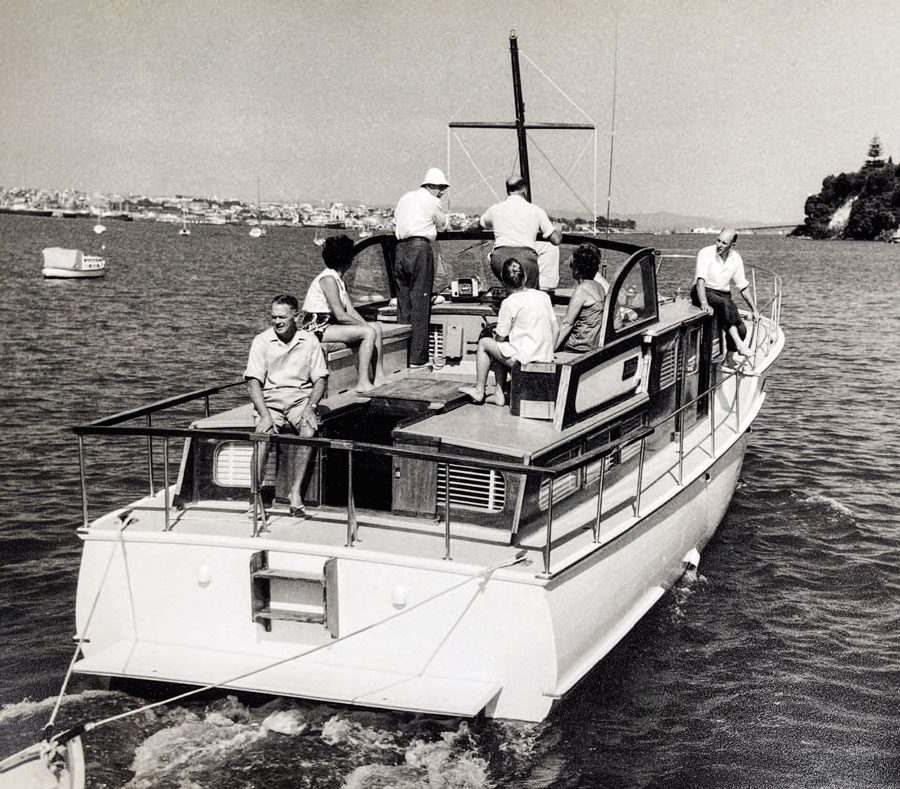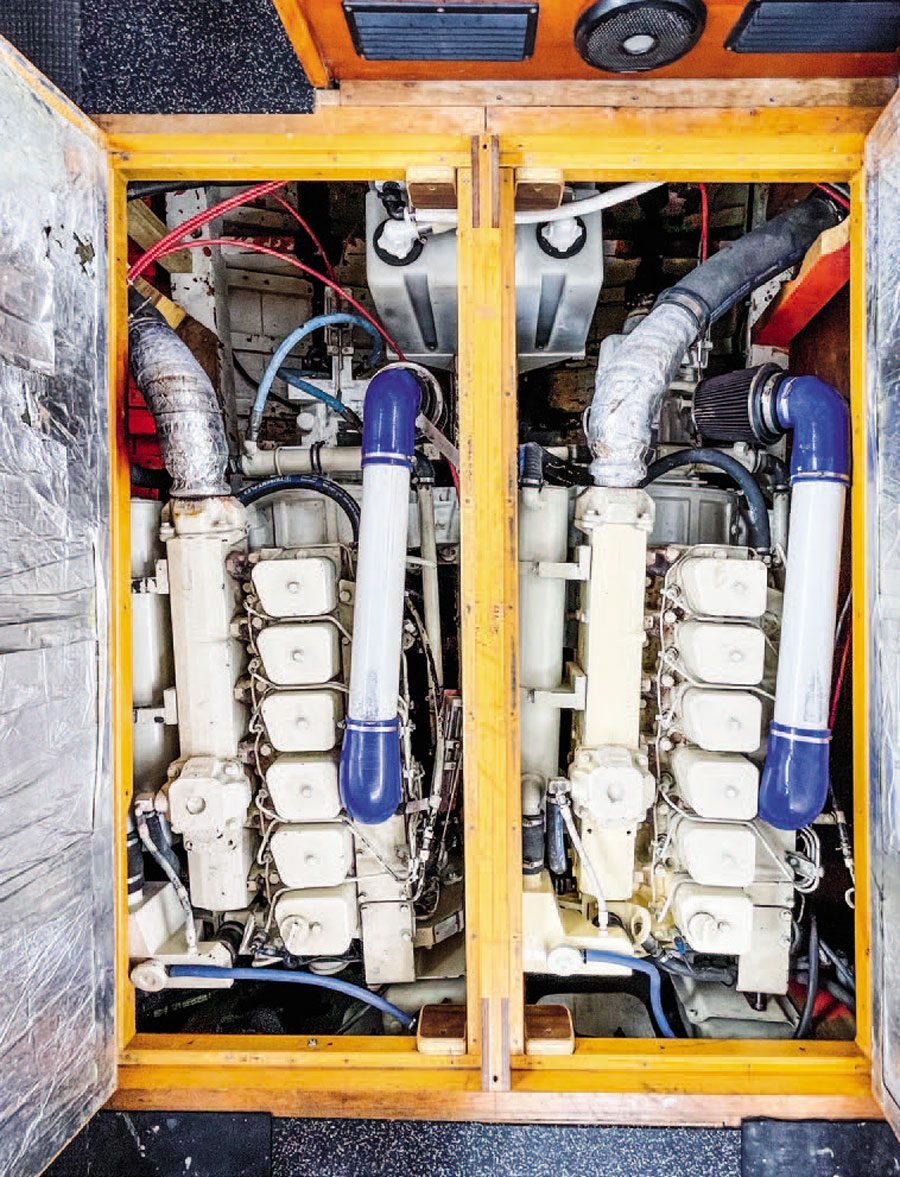

Launched in 1961, the 50-foot bridgedecker Altair recently emerged from a 12-month restoration and, like her bright namesake in the northern hemisphere’s evening skies, is once again enriching the lives of all who see her.
Altair is believed to be one of the last (and largest) bridgedeckers designed and built by Ponsonby boatbuilder Mac McGeady (Supreme Craft) – and she is, in fact, one of only a few bridgedeckers produced by the yard. Fittingly, she is widely considered one of the finest examples of his craftmanship – a splendid creation in kauri and mahogany. The yard ceased operation in 1965.
She carried the battle scars of 60 years of wear-and-tear until late last year, when her owner – Auckland classic boat enthusiast Simon Ventura – elected to breathe new life into the old lady. More on that in a moment.
 The massive kauri tree felled in the late ‘50s specifically to build Altair.
The massive kauri tree felled in the late ‘50s specifically to build Altair.
The launch was built for Auckland’s Stan Horner and she was unusual for the period in that she was equipped with a flybridge. Horner travelled extensively for business and during trips to the US came across numerous examples of launches with flybridges. He had to have one.
Also remarkable for her age, she boasts a comprehensive provenance, down to the details of the massive kauri tree felled and milled in the late 1950s for her ribs, stringers and continuous-plank, single-skin hull.
McGeady did a great job, but the project nearly ended in tears because Altair wouldn’t fit through the door of his Summer Street shed. Luckily the flybridge was removable. Even then, legend has it that the delicate manoeuvring ground to a halt when the superstructure hit the top of the roller door. The culprit was a hacksaw blade. With it removed the boat inched forward. Once outside, the flybridge was refitted.
 Altair at Okahu Bay – circa mid-1960s.
Altair at Okahu Bay – circa mid-1960s.
Altair is also unusual in that Horner purchased her twice. His son Ross takes up the story: “I was about 12 when Dad acquired her, and he loved the boat. But after a few years – around ’66 or ’67 – he decided he wanted a bigger and more comfortable boat. So he sold Altair and commissioned a new Salthouse launch.
“He then discovered there was a three-year wait from the Salthouse yard and, without a boat, he became increasingly grumpy and frustrated. And then, for whatever reason, Altair came back on the market – so he bought her to cover the interlude. He always grizzled that he paid more than he’d sold her for!” Ross has fond memories of the vessel. “My childhood was peppered with boating trips – most weekends I was picked up from the school bus on a Friday and taken straight to the boat on her Okahu Bay mooring. The Coromandel and Great Barrier were favourite destinations.”
He spent hours in the open flybridge (“no one worried about the sun in those days – no one wore dark glasses or sunscreen”). Altair’s twin six-cylinder, 100hp Ford diesels gave her a comfortable cruising speed of around 8 knots. The launch also carried Ross’ 11-foot Moth sailing dinghy on her foredeck.
 Looking better than new – Altair at her recent relaunching.
Looking better than new – Altair at her recent relaunching.
Why Altair? A couple of reasons, says Ross. McGeady, it seems, favoured a naming convention for his boats – they all started with the letter A. “And Dad was a bomber pilot in the war. He used the star Altair as a navigational aid when returning from bombing missions. He said he felt the star guided him home – if he could see it, he would get the crew back safely. I guess he transferred that sentiment to the boat.
“It brings me great joy to see her restored and back on the water. She’s changed, of course, but the roots of the old ship are still there. I love seeing people do this sort of thing – bringing older vessels back to life – all credit to Simon.”

ALTERATIONS
Simon bought Altair about 10 years ago, knowing he would initially enjoy the old dame as a comfortable cruiser for his young family, but that a restoration was always on the cards. As someone with a soft spot for old classics, he’s been involved with numerous restoration projects.
“Including me, she’s only had four owners – actually three if you consider that Stan Horner owned her twice. And the owner before me introduced a few notable modifications. For a start she was 43-feet LOA when she was launched – the owner after Horner’s ‘second-time-around’ added the stern cockpit, extending her LOA to 50 feet. He also enclosed the open flybridge and built an internal staircase for easier access to it.”
 Ross has many happy memories of cruising aboard Altair.
Ross has many happy memories of cruising aboard Altair.
Most of Simon’s restoration project was aesthetic – a complete paint and varnish job, with substantial repairs to stanchion bases, beltings and combings, and replacing all the window frames (14). “But I also beefed up some of the frames where I felt she was weak, mainly under the engine beds, and did some re-caulking around the garboard.” He installed a second shower and built a new cockpit behind the flybridge, creating a more user-friendly space.
“The Cummins engines were mechanically sound and didn’t need any major work, but I completely re-engineered the drive train – I had no choice. The existing counter-rotating props only had one thing in common – three blades. Pitch and diameter were different. With new, matching props I installed new shafts and bearings and realigned the struts.

“My engineer predicted a significant improvement in performance – an extra two knots – and he was spot on. She used to cruise at 8.5 knots with the engines turning over at 1,800rpm – she now cruises at 9.5 knots at 1,600rpm.” It’s not clear when the Cummins engines were installed, but their mountings are unusual – rather than being parallel to the keel, the engines and drive train are ‘fanned’ outboard, about 10o from the keel line.
Simon fell in love with boat the moment he saw her, a gut instinct corroborated by the surveyor. “My old surveyor friend Jack Taylor was too frail to inspect her but asked how many owners she’d had. Four, I answered. ‘Oh, she’ll be good then.’ How so? I asked. ‘Well,’ he said, ‘it’s obvious she never scared anybody – either in terms of handling or maintenance.’ A shrewd insight from a wise old surveyor!”
 She retains a relatively traditional helm station.
She retains a relatively traditional helm station.
Simon acknowledges he could have bought a much more modern vessel and spared himself a lot of work (and money). Why invest in Altair?
“Putting aside the commercial realities, I have a thing for vintage and classic boats. I want to save as many as I can. Unfortunately, I only have one lifetime and limited funds – but she was in such good condition. She had to be preserved for future generations.”
 Note how the twin Cummins engines are ‘fanned’ outboard from the keel line.
Note how the twin Cummins engines are ‘fanned’ outboard from the keel line.
In the 10 years he’s owned her, Altair has developed something of a reputation around the Hauraki Gulf anchorages – she’s a party boat. “I’m not sure why, but she’s the default dinner boat. We will pull into an anchorage and within hours there will be 8–10 rubber duckies tied up the stern. She has happy genes – everyone seems to have good time aboard her.”
It’s not hard to imagine that Altair’s scintillating legacy will extend for many more years. BNZ
 Simon Ventura surveying the scenery from a wonderfully revitalised Altair.
Simon Ventura surveying the scenery from a wonderfully revitalised Altair.
ALTAIR SPECIFICATIONS
loa 50” (originally 43”)
beam 12” 6”
construction Single-skin 1¼” kauri planking
water 1,800 litres
fuel 1,800 litres
engines 2 x 200hp Cummins
top speed 10 knots





